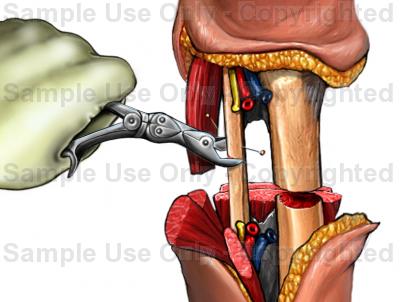Amputation procedure - surgery, rehabilitation, complications and risks

What is Amputation Surgery
Amputation procedure - Removal or loss of a limb or body part. Amputation may be surgical, in which the removal is intentional to treat a disease condition, or traumatic, in which accidental injury results in the loss of the body part. Most amputations involve digits (fingers and toes) and limbs. In the United States, complications of DIABETES account for the majority of surgical amputations of the foot and lower leg; traumatic injury accounts for most upper extremity amputations. Other causes of amputation include uncontrollable OSTEOMYELITIS (INFECTION of the BONE), severe PERIPHERAL VASCULAR DISEASE (PVD), and tumors.
US surgeons perform nearly 200,000 amputations each year. Surgical amputation is a treatment of last resort, becoming an option only when other treatments fail and leaving the limb threatens the person’s health. Surgical amputation is a major OPERATION performed in a hospital. For most amputations the person stays 2 to 10 days in the hospital.
Amputation Surgical Procedure
With the person asleep under general ANESTHESIA, the surgeon cuts through the SKIN and MUSCLE to reach the bone, structuring the incisions so tissue remains to create a flap that covers the surgical wound. The surgeon may need to use a saw to cut the bone, though in some circumstances the amputation takes place at the JOINT (called a disarticulation). For limb amputation the surgeon shapes the bone ends and remaining tissue to support a prosthesis.
When there is no infection or risk for infection is minimal, the surgeon closes the surgical wound by suturing the muscles together around the bone and pulling tissue and skin over the end in a flap.
Amputation - Risks and Complications
The primary risks of amputation are excessive bleeding during surgery and infection and poor HEALING after surgery. The risk for infection is highest in people who have problems with BLOOD circulation in the extremities, such as may occur in PVD or diabetes. People who have diabetes may be slow to heal from the surgery of amputation, usually an extension of the complications of diabetes that made necessary the limb amputation. Complications such as failure to heal or spreading GANGRENE (dead tissue) require a follow-up surgery to attempt to improve the surgical wound for better healing.
Amputation - Outlook and Lifestyle Modifications
Recovery and limitations depend on the type of amputation and the underlying health conditions. With focused PHYSICAL THERAPY and OCCUPATIONAL THERAPY, most people can return to a satisfactory level of function and participation in many of the activities they previously enjoyed. A PROSTHETIC LIMB often allows nearly normal function. Adaptive devices and equipment can improve safety, mobility, and independence. People who have amputations as a result of severe chronic disease such as diabetes or PVD often find they have better QUALITY OF LIFE after amputation because the remaining tissue of the limb is healthy.
Amputation may be emotionally difficult for the person as well as for his or her loved ones. The loss of a body part may affect the person’s selfimage and self-esteem. Some people feel guilty about their health situations, and others feel angry or depressed. The health-care team generally includes a social worker or psychologist to help the person go through the grieving process and cope with the range of feelings and emotions.
See also ACCIDENTAL INJURIES; OCCUPATIONAL HEALTH AND SAFETY; PHANTOM PAIN; SURGERY BENEFIT AND RISK ASSESSMENT.
Open discussion on the topic Amputation procedure - surgery, rehabilitation, complications and risks
Similar interests
- Nuovi Casino
- Casinos Not On Gamstop
- UK Casinos Not On Gamstop
- Casinos Not On Gamstop
- UK Casinos Not On Gamstop
- Casino Non Aams Italia
- Slot Sites Not On Gamstop
- Meilleur Casino En Ligne
- Non Gamstop Casino Sites UK
- Meilleur Casino En Ligne
- Casino En Ligne France
- Best Non Gamstop Casinos
- Casinos Not On Gamstop
- UK Casino Not On Gamstop
- Casinos Not Signed Up To Gamstop
- Best Slot Sites UK
- Non Gamstop Casino Sites UK
- Online Casinos Nederland
- Online Casinos Nederland
- Casinos Not On Gamstop
- Best New Uk Casinos Not On Gamstop
- Casino Non Aams
- Non Gamstop Casinos UK